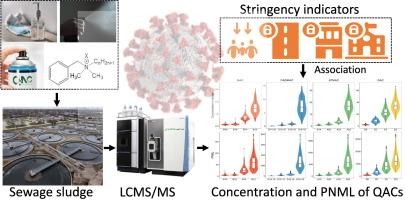A longitudinal study of mass loads of quaternary ammonium compounds in sludge associated with COVID-19 Stringency Index indicators in Beijing, China
IF 9
Q1 ENVIRONMENTAL SCIENCES
引用次数: 0
Abstract
This study estimated population normalized mass loads (PNML) of quaternary ammonium compounds (QACs) including alkyltrimethylammonium chloride (ATMAC), benzylalkyldimethylammonium chloride (BAC), and dialkyldimethylammonium chloride (DADMAC) and assessed their associations with COVID-19 containment policies. We collected daily sludge specimens from five wastewater treatment plants in Beijing from July 2020 to May 2022. Using liquid chromatography-tandem mass spectrometry, we determined QAC concentrations and backward-estimated their PNML. We used COVID-19 Oxford Stringency Index and its metrics to measure containment policies. We analysed the relationship between QACs and containment measures using linear regression models. Among QACs categories, ΣBAC had median PNML of 94.54 μg/person/day, ΣDADMAC had 282.36 μg/person/day, and ΣATMAC had 802.55 μg/person/day. The ΣQACs median PNML was 1186.12 μg/person/day. The PNML of QACs appeared to have general increasing trend over time and were significantly different across seasons. PNML increased on average by 11 μg/person/day (95 % CI: 3.2, 19) for ΣBAC per 10-unit increase in Stringency Index score. Notably, higher stringency levels in three index indicators — workplace closures, internal movement restrictions, and public gathering restriction were positively associated with higher ΣQACs PNML. Sludge derived QACs may reflect the magnitude of disinfectant use at different stages of pandemic control response.

与 COVID-19 严格指数指标相关的中国北京污泥中季铵化合物质量负荷纵向研究
本研究估算了包括烷基三甲基氯化铵(ATMAC)、苄基二甲基氯化铵(BAC)和二烷基二甲基氯化铵(DADMAC)在内的季铵化合物(QACs)的种群归一化质量负荷(PNML),并评估了它们与 COVID-19 围控政策的关联。2020 年 7 月至 2022 年 5 月期间,我们每天从北京的五家污水处理厂采集污泥标本。我们使用液相色谱-串联质谱法测定了 QAC 的浓度,并反向估算了其 PNML。我们使用 COVID-19 牛津严格指数及其指标来衡量遏制政策。我们使用线性回归模型分析了 QAC 与遏制措施之间的关系。在 QACs 类别中,ΣBAC 的 PNML 中位数为 94.54 μg/人/天,ΣDADMAC 为 282.36 μg/人/天,ΣATMAC 为 802.55 μg/人/天。ΣQACs 的 PNML 中位数为 1186.12 微克/人/天。随着时间的推移,ΣQAC 的 PNML 呈总体上升趋势,并且在不同季节有显著差异。严格指数每增加 10 个单位,ΣBAC 的 PNML 平均增加 11 微克/人/天(95 % CI:3.2,19)。值得注意的是,工作场所关闭、内部行动限制和公众聚集限制这三项指数指标的严格程度越高,ΣQACs PNML 就越高,两者呈正相关。污泥得出的 QACs 可能反映了大流行控制应对措施不同阶段的消毒剂使用量。
本文章由计算机程序翻译,如有差异,请以英文原文为准。
求助全文
约1分钟内获得全文
求助全文
文献相关原料
公司名称
产品信息
百灵威
HPLC grade methanol
¥14.00~¥55867.47

 求助内容:
求助内容: 应助结果提醒方式:
应助结果提醒方式:


